B.
B. & Q. band
Wow, what a fantastic band this is! Right from the start in
81 B. B. & Q. band showed what real music is about. With
a smooth and irresistible pop funk sound with highly addective
and catchy melodies they were a perfect blend of European
producing skills and American vocalists that made this band
to a classic!
The
background
Jacques Fred Petrus, the man behind Change and Peter Jacques
band and others, was also the force behind B. B. & Q.
band. Being the tycoon of Milan (Italy) based Goody Music
Productions (GMP) since the second half of the 70s together
with his co-founder, song writer, arranger and producer wizard
Mauro Malavasi, he had plans ready for a hot new project.
After a certain amount of success with his first productions
in the late 70s Petrus wanted more of the US market. Change
became a real breakthrough in 1980, but Petrus didn't stop
there.
In
November 1980 Petrus went to the studios in Bologna in Italy
with his Italian musicians Mauro Malavasi (piano and synthesizer),
Davide Romani (bass guitar), Paolo Gianolio (guitar) and Rudy
Trevisi (saxophone). The basic melodies that were written
by the first three together with Marco Tansini surfaced in
1981 on the albums of Change and B. B. & Q. band. When
these instrumental melodies were finished Petrus flew in a
couple of American musicians to create a small rhythm section
including Terry Silverlight (drums), Doc Powell (guitar) and
Onage Allen Gumbs (Synthesizer). Gumbs was fired and sent
home after a few sessions probably because Malavasi could
play those repetitive parts himself and didn't need anyone
else's input as far as creating them and by that save Fred
the money at the same time. Even though the melodies already
existed they were kept away from the Americans at this stage.
Drummer Silverlight recalls that he never heard the melodies
while recording, just himself, bass guitar and a pre-existing
synthesizer part on tape.
About
six months later back in NYC a vocal auditions was being held
at Media Sound Studios where every great singer in New York
and elsewhere were showing up. Petrus finally hired singers
like Ike Floyd, Gordon Grody, Fonzi Thornton and Diva Gray
to name a few. All more or less renowed but all great singers.
A
perfect start in 1981
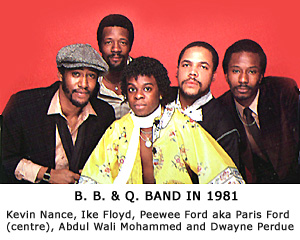 When
the 12" of "On the beat" was released B.
B. & Q. band was
a faceless studio concept (like all the creations created
by Petrus) but before the release of the
debut album on Capitol records in September 1981 it was necessary
to change that. Later member of the band, Kevin Robinson,
recalls that: "Capitol Record pressured Petrus for
'faces' for the music; so he gave them faces. However, when
the record took off, he need[ed] musicians and performers
who could execute the music."
When
the 12" of "On the beat" was released B.
B. & Q. band was
a faceless studio concept (like all the creations created
by Petrus) but before the release of the
debut album on Capitol records in September 1981 it was necessary
to change that. Later member of the band, Kevin Robinson,
recalls that: "Capitol Record pressured Petrus for
'faces' for the music; so he gave them faces. However, when
the record took off, he need[ed] musicians and performers
who could execute the music."
The
"faces" (seen on the backside of the album cover)
became Kevin Nance, Ike Floyd, Paris Ford, Abdul Wali Mohammed
and Dwayne Perdue. All of them together with Kevin Robinson,
Paris Ford, Mel'lisa Morgan, Ethel Beaty, Skip Anderson and
LaLa Cope - who Petrus terminated before the tour began -
became the touring group on the following "On
the Beat" tour with Mic Murphy as road
manager.
The
album, that reached the #72 spot on Billboards black albums
chart and #109 spot on Billboards pop albums chart,
was produced by Petrus and Mauro Malavasi. In reality though
the creation of all tracks (they were all composed,
arranged and conducted by
Malavasi)
except Tansini's
ballad "Don't say goodbye" and
the entire production procedure
was the work of the brilliant Malavasi.Petrus
had the (bad) habit to name him self as the producer or co-producer
even though that rarely happen. As
so many times during the late 70s, Italy and Bologna was once
the playground of the recordings of the music with entirely
italian musicians with just a few exeptions. And like earlier,
the music was finished in Italy and finilized in New York
where "...lyricists, background vocalists, and lead
vocalists from America were used to give the songs an Americian
flavor..." (Kevin Robinson) before release.
The
sound
The
music of B. B. & Q. band can be described as discofunk,
or popfunk as former Change member Jeff Bova's once said.
Compared to the only other Petrus/Malavasi production that
year, "Miracles " by Change, B. B. & Q band
had a slightly more funky sound but was still as accessible
and appealing as the album of Change. The similarities with
Change weren't a coincident however. The way Petrus ran his
empire was by letting Malavasi and and a few others of the
italians create the music, arrange, conduct and produce it
(under Petrus' given guidelines) and then by himself place
them on the albums he thought suited them the best. Only Petrus
did know where each track were going to be placed at the end.
That procedure was a trademark of him and was performed continuously
all the way from the start to the end. That's why all tracks
written that year could easily could have been used either
on the albums by Change or B. B & Q. band.
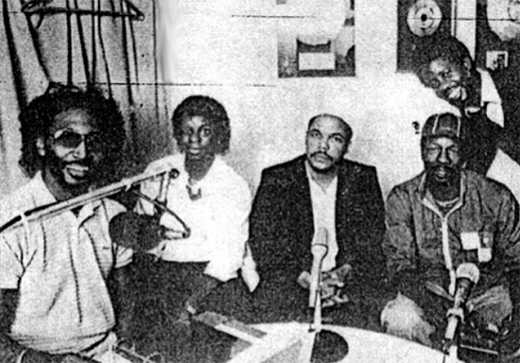
From
left to right: Frankie Crocker, noted NY radio personality
on WBLS, interviews Peewee Ford (Paris Ford), Abdul Wali Mohammed,
Ike Floyd from the B. B. & Q. band and Capitol Records
promotions manager Bill Reid in 1981.
Like
Change, the distinctive features of B. B. & Q. band were
to a large extent emphasized on the role of the guitars. One
can even say that, like their great opponent Chic, the guitars
were the trademark of all the Little Macho productions. They
were played distinctively that made the strings glow and stretch
to the limit and perfectly spiced up with intelligently used
funk influences. Both the guitar and bass guitar players of
Gianolio and Romani really showed their great potential and
sometimes even Gianolio's classic acoustic guitar skills shined
through more than just on a subtle level; the result was just
fantastic! But the guitars were never taken over Malavasi's
arrangements. They were instead perfectly matched, and incorporated
in a balanced way with that polished, well-produced and transparent
airy sound that the rest of the instruments delivered. The
final result was a highly danceable, seductive and delicate
production thanks to the amazing genius of Malavasi.
The
first track on the album was something that no one was going
to forget in a hurry, whether you talk past or present. If
you haven't heard "On the beat", that reached the #8 spot
on the Billboard black singles charts, you certainly got something
to do! 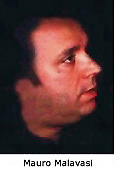 This
is truly one of the best tracks ever in its genre and with
its fast and catchy melody, lovely song by Ike Floyd, intensive
guitars and deep bass lines. It includs an indescribable hypnotic
intro performed by a synth gone crazy. This puts you on the
floor, whether you want it or not! And the story didn't end
there as the album included three more outstanding eternal
hits. The strongest among them was "Time for love" (#72 spot
on Billboards black singles chart), an absolutely perfectly
balanced track with a short but intense dreamy break after
three and a half minutes with punchy guitars, infectious strings
and demanding trumpet calls. Also more disco like "Mistakes"
and dreamy "Starlette" (that was originally intended for
the debut album of Change) were competent songs that got
much in common with the tracks on Change's album that same
year. Although B. B & Q. band emphasized heavily on speedy
tracks the album also included the sad, but yet irresistible
ballad of "Don't say goodbye" and a somewhat misplaced mid
tempo reggae imitation that many artist did add at the time
of strange reasons. This
amazing and classic album is perhaps Malavasi's most brilliant
and genius one.
This
is truly one of the best tracks ever in its genre and with
its fast and catchy melody, lovely song by Ike Floyd, intensive
guitars and deep bass lines. It includs an indescribable hypnotic
intro performed by a synth gone crazy. This puts you on the
floor, whether you want it or not! And the story didn't end
there as the album included three more outstanding eternal
hits. The strongest among them was "Time for love" (#72 spot
on Billboards black singles chart), an absolutely perfectly
balanced track with a short but intense dreamy break after
three and a half minutes with punchy guitars, infectious strings
and demanding trumpet calls. Also more disco like "Mistakes"
and dreamy "Starlette" (that was originally intended for
the debut album of Change) were competent songs that got
much in common with the tracks on Change's album that same
year. Although B. B & Q. band emphasized heavily on speedy
tracks the album also included the sad, but yet irresistible
ballad of "Don't say goodbye" and a somewhat misplaced mid
tempo reggae imitation that many artist did add at the time
of strange reasons. This
amazing and classic album is perhaps Malavasi's most brilliant
and genius one.
The
second album
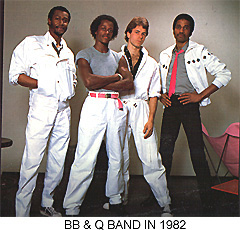 The next album was released in 1982 once again on Capitol
titled "All night long" (#32 spot on Billboards black albums
chart). With a view of their beloved New York shining up at
night they continued to point out their origin. The front
cover showed the two twin towers of World trade center. The
first album was a studio project. Now a more group like identity
was materialized. From the "On the beat" tour in
1981/1982 1982 Petrus brought in Kevin Nance and Kevin Robinson
that Petrus appointed as band leader. Consequently B. B. &
Q band in 1982 featured Kevin Nance on keyboards, Kevin Robinson,
that not only played guitar but also became the lead singer
after Ike Floyd, Chieli Minucci (a first generation Italian-American)
on guitar and Tony Bridges on bass guitar. Kinky foxx contributed
with Johnny Kemp, the later successful solo artist, as background
singer.
The next album was released in 1982 once again on Capitol
titled "All night long" (#32 spot on Billboards black albums
chart). With a view of their beloved New York shining up at
night they continued to point out their origin. The front
cover showed the two twin towers of World trade center. The
first album was a studio project. Now a more group like identity
was materialized. From the "On the beat" tour in
1981/1982 1982 Petrus brought in Kevin Nance and Kevin Robinson
that Petrus appointed as band leader. Consequently B. B. &
Q band in 1982 featured Kevin Nance on keyboards, Kevin Robinson,
that not only played guitar but also became the lead singer
after Ike Floyd, Chieli Minucci (a first generation Italian-American)
on guitar and Tony Bridges on bass guitar. Kinky foxx contributed
with Johnny Kemp, the later successful solo artist, as background
singer.
Once
again the release was
produced by Petrus, but only on paper. The highly regarded
Luther Vandross was no longer a background singer like he
was in 81 but others, both new and old names were stepping
in. The background singers included the superb Tawatha Agee
(Mtume), Timmy Allen (Change) and Alyson Williams (High fashion)
to name a few.
Now
when everything was set the audience were exited to know if
the new lineup were up to something good, and yes they were!
The earlier more or less monopoly among the Italians of Malavasi
and Romani when it came to writing and producing was now much
more mixed up with American skill and influences. Even so,
the mighty Malavasi wrote three of the tracks including the
hit "Children of the night". The rest of the written
material was shared between Kevin Robinson, with two tracks,
and ex Breakwater member Kae Williams. Finally Tony Bridges
and Timmy Allen wrote one each. The album got some infectious
tracks that are almost on the same level as the debut. Together
with Robinson's voice working passionate true the songs the
result was over average. The most appealing tracks are sing-a-long
"All night long (she's got the moves I like)", electrofunkish
"Imagination" (#21 spot on Billboards black singles chart)
and the already mentioned Malavasi penned smooth and slender
"Children of the night". All of them really great dancebeats
with catchy melodies that very well could match the most distinguished
tracks from the album in 81. Also the listener finds some
nice ballades on the album.
1983
- New directions
B.
B. & Q. band was still on top in 82-83, so what to do?
Well, why not produce a bad album, with less glow and enthusiasm.
That was exactly what happened in 1983 when "Six million times"
was released on Capitol records for the last time. Although
the foxy lady on the front cover looked all right the inside
was not as seductive and interesting as the outside and the
band had lost the sparkle from the two earlier albums. In
addition the skills of the main song writer Malavasi were
used on the albums of High fashion and Change instead, something
that had great impact on the final musical result of "Six
million times". As a significant result of that both
Change and High fashion launched albums considerably stronger
including several great tracks penned by Malavasi like "Tell
my way" by Change and "Stay" by High fashion.
A
crucial explanation to why Petrus' decided to not use Malavasi
on B. B . & Q. band's third album except for one mediocre
track might also be explained by his grooving financial problems
that affected the relationship with the golden calf's of Malavasi
and Romani. That also made Petrus invite new hungry America
songwriters at the expense of the old Italians and B. B. &
Q. band got most affected by these changes. One of these Americans
that stepped forward from the album in 82 and received that
writing freedom was Kevin Robinson. He wrote almost all tracks
on "Six million times". Robinson was, and is, absolutely
a good musician and a rather competent singer but not as near
as good songwriter. He simply couldn't compete with the master
Malavasi. This move of Petrus was the main reason to the dramatic
drop in quality and commercial success of B. B. & Q. band
in 1983.

The
lineup from the last album continued over the 1983 season
as well with the exception of Kevin Nance that left in favor
of Bernard Davies on drums. Although Robinson still was the
lead vocalist and wrote much of the material together with
his work as a co-producer, it didn't help. There are a couple
of decent tracks on the record however including the "Keep
it hot", the electrofunkish "Stay", that was the perhaps most
enjoyable one. One got the feeling that these tracks must
have been a rest product from the "All night long"
album. "Six million times" is the most memorable
track on side two with a rather tasty modern beat. On a whole
the tracks under Robinson's pen was harder, more modern. An
obvious resemblance with the ultra hip sound of The Time/Prince
and their more rock oriented funk is also present. Especially
on "She's a passionate lover" and "Six million
times" that is obvious. Even though Robinson, that with
out a doubt was influenced by their sound, he couldn't quite
manage to reach the same plateau as Prince. One year later
after Robinson's departure he tried again as a co-producer
with a slighly better result on the short lived band Network's
rare and only album "I need you" in 84. The realatively
musical success the managed to reach was in reality much due
to the brilliant talents of the ex-Mtume member Howard King
that wrote most tracks. Despite the loss of the earlier on-the-floor
feeling and the genuine spirit and sparkle B. B. & Q band
hadn't played their last tune yet!
B.
B. & Q. band searching for inspiration
In
82 Petrus and Malavasi didn't work together as well as before
and finally their companionship broke apart in 83 due to econimical
problems and the collapse of their Goody music production
company. Petrus continued as a producer and executive producer,
but Malavasis exellent talent of writing the music was lost.
If that was not bad enough, Petrus had also lost the highly
used Romani, Gianolioi and Trevesi due to the same economical
problems. B.
B. & Q. band now stood in front of some heavy economical
and musical problems, and the future was uncertain, especially
after the flop in 83 that made the situation even tougher.
Petrus
however didn't gave up. Change album "Change of heart" in
84 had instead of Malavasi and the other main Italians used
upcoming producers/writers Jimmy Jam and Terry Lewis with
great success. He understood that their new and characteristic
sound was something not to forget, a notion that later was
implemented on BB's album in 85 with its clear influences
from Jam and Lewis. He couldn't use Jam and Lewis themselves
once again however, because they didn't get paid either and
soon left Petrus like the Italians. So with all his experience
and knowledge, what did Petrus decide for B. B. & Q. band's
future? First of all Petrus waited two years for the release
of B. B. & Q. band's fourth album on
Elektra records featuring a completely new band including
none of the earlier band/touring members. Lead singer Kevin
Robinson had a lot of work as both as singer, player and producer
at the time for such great acts like Mtume, Stephanie Mills,
The Spinners, Melba Moore, Freddie Jackson (title track -
double platinum), the Bar ays, Sweet Obsession, Chad, Patti
LaBelle, Network and many others and left the band. But the
over all reason they left was that Petrus didn't pay the members
or the musicians and even the engineers for that matter anymore
and no gigs were going on with, so they simply left him for
other projects.
Petrus
was now almost completely deserted by everyone. He was in
this precarious situation forced to catch other musicians
and singers and invited the marvelous singer Curtis Hairston
to be lead vocalist and used the old fox Kay Williams to write
all songs as well as playing keyboards and piano. Williams
had earlier participated on B. B. & Q. bands second album
as songwriter and bassist. The new B. B. & Q. band also
included Ullanda McCullough as background vocalist (she was
background vocalist on Change's 81 album), Timmy Allen on
bass and Michael Campbell on Guitar, both from Change. Petrus
decided to use Allen and Campell from Change instead of taking
anybody from outside. Both had played bass and guitar respectively
on BB's second release. Once again Petrus took advantage of
what was left of the in-house talents and used them in the
band.
Back
on top, but just for a year
 In
85 it was time to release "Genie". Petrus had now left
Capitol and released the set on Elekta instead, probably because
of the bad selling figures that their last album stood for.
When you're down, you can lie down or rise, B. B. & Q.
band did the latter after their poor release in 83. I better
say it right away, this was a great comeback! The sound was
new, modern and tough and the beautiful and funky cover corresponded
perfectly with the music! A critical mind might say the release
included way too much programmed drummachines without the
warm feeling of instrumental joy. To a certain degree that
might be the case especially on tracks like "On the shelf"
and "Main attraction" but they did not exclude a
nice melody and the warmth was to be found there as well like
the splendid "Won't you be with me tonight" clearly
shows. The latter could more easily be found on the rest of
the album that is more soft and dreamlike. All songs, whether
hard or soft, were performed with a masters touch by the wonder
kid Curtis Hairston's sensitive voice that really helped to
create a perfect feeling drawn to the very limit of pleasure.
To use the old man Kay Williams and letting him do all the
work was brilliant as well. The lovely long version of the
title track is a great laid back, smooth soul piece that makes
you sing along.
In
85 it was time to release "Genie". Petrus had now left
Capitol and released the set on Elekta instead, probably because
of the bad selling figures that their last album stood for.
When you're down, you can lie down or rise, B. B. & Q.
band did the latter after their poor release in 83. I better
say it right away, this was a great comeback! The sound was
new, modern and tough and the beautiful and funky cover corresponded
perfectly with the music! A critical mind might say the release
included way too much programmed drummachines without the
warm feeling of instrumental joy. To a certain degree that
might be the case especially on tracks like "On the shelf"
and "Main attraction" but they did not exclude a
nice melody and the warmth was to be found there as well like
the splendid "Won't you be with me tonight" clearly
shows. The latter could more easily be found on the rest of
the album that is more soft and dreamlike. All songs, whether
hard or soft, were performed with a masters touch by the wonder
kid Curtis Hairston's sensitive voice that really helped to
create a perfect feeling drawn to the very limit of pleasure.
To use the old man Kay Williams and letting him do all the
work was brilliant as well. The lovely long version of the
title track is a great laid back, smooth soul piece that makes
you sing along.
The
two most prominent tracks were "Genie" (no 40
on Billboards top 40 in 85) and
"Dreamer" (no 35 on Billboards top 40 in 86) that got
some great values with a smoth and spell bounded dreamy sound!
Two similar harder
tracks are also representative in the sing-a-long "Main attraction"
and the electro-funk like "On the shelf" (#72 spot on Billboards
Hot R&B/Hip-hop singles & tracks chart) that included a blues/rock
break of the highest musical standard, although nothing sensational,
well worth a closer attention nonetheless. Also the good ballad
descent "Minutes away" and the fast and scratchy "Riccochet"
were included. All together, although not a classical album,
this is a good example of mid 80 Jam/Lewis influenced music
well worth buying.
The
end and beginning of other projects
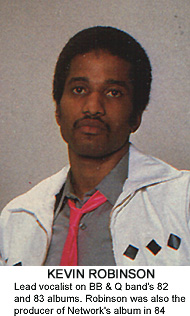 B.
B. & Q. band didn't release any more albums after "Genie"
mainly because of the tragic death of Petrus in 87 and the
band was history. What happened to the different groupmembers
after the split are not known except for a few. Curtis Hairston
released the dreamlike "The morning after" on his one an only
album in 86. Many of the tracks from the album were very similar
to the ones on "Genie" and could very well have been on that
record. In 92 he appeared as background singer on former High
fashion member Alyson Williams self titled album. The bussy
Chieli Minucci, a scholar in classic guitar, became famous
and stepped out from the studio to wrote songs to artists
like Chaka Kahn and Roberta Flack but did also worke as a
producer. His very special way of performing jazz was introduced
on his debut solo album in 95. The great Mauro Malavasi continued
his work as a producer and songwriter for Change, High fashion
until 83. He then left his work with Petrus and continued
on his own with world famous artists like Andrea Bocceli and
the beautiful Dalida. Paris Ford continued his work and as
a musician. He released his first single ”Be My Girl” (# 69
on Billboard's Top 100 R&B/Dance chart) on Streetwise records
(Arthur Baker's label) and has been playing and/or on tour
with such great acts like Rick James, New Edition, Evelyn
“Champagne” King, Lenny White, Invisible man Band and Planet
patrol to mention just a few. Today he is still busy working
with new projects after his biggest selling single "2 Far"
featuring ex Change member James Robinson that was released
in 1989. Paolo Gianolio continued playing guitar for several
artists like Eros Ramazzotti, Anna Oxa and Fiorella Manoia.
Timmy Allen became an even more successful songwriter and
producer to singers like Lillo Thomas and Milie Jackson. Today
Allen still works in the music business with acts like Britney
Spears and Backstreet boys.
Kevin Robinson had a lot of engagements and played, sang,
and produced for artists such as Mtume, Stephanie Mills, The
Spinners, Melba Moore, Freddie Jackson (Title track - double
platinum), the Bar Kays, Sweet Obsession, Chad, Patti LaBelle,
and many others. Robinson was also the force behind the hard-to-find
group Network that released their one and only album "I need
you" in 84 on Salsoul (maybe just on Rams horn when a rumor
has it that Salsoul never released it but Rams horn did, with
or without their permission) that he produced and played
guitar on. Network's sound is similar to B. B. & Q. band
in 82 and 83 but with a more funkier groove. Johnny Kemp that
was one of the background singers on BB's second album was
also a member of Network as lead vocalist on their hit "Cover
girl" [Sample].
Also Raymond Jackson from Mtume played bass on this album.
That same year when the Network album was released he also
joined Mtume as bassist on their excellent 1984 album. Read
more about Network on here
B.
B. & Q. band didn't release any more albums after "Genie"
mainly because of the tragic death of Petrus in 87 and the
band was history. What happened to the different groupmembers
after the split are not known except for a few. Curtis Hairston
released the dreamlike "The morning after" on his one an only
album in 86. Many of the tracks from the album were very similar
to the ones on "Genie" and could very well have been on that
record. In 92 he appeared as background singer on former High
fashion member Alyson Williams self titled album. The bussy
Chieli Minucci, a scholar in classic guitar, became famous
and stepped out from the studio to wrote songs to artists
like Chaka Kahn and Roberta Flack but did also worke as a
producer. His very special way of performing jazz was introduced
on his debut solo album in 95. The great Mauro Malavasi continued
his work as a producer and songwriter for Change, High fashion
until 83. He then left his work with Petrus and continued
on his own with world famous artists like Andrea Bocceli and
the beautiful Dalida. Paris Ford continued his work and as
a musician. He released his first single ”Be My Girl” (# 69
on Billboard's Top 100 R&B/Dance chart) on Streetwise records
(Arthur Baker's label) and has been playing and/or on tour
with such great acts like Rick James, New Edition, Evelyn
“Champagne” King, Lenny White, Invisible man Band and Planet
patrol to mention just a few. Today he is still busy working
with new projects after his biggest selling single "2 Far"
featuring ex Change member James Robinson that was released
in 1989. Paolo Gianolio continued playing guitar for several
artists like Eros Ramazzotti, Anna Oxa and Fiorella Manoia.
Timmy Allen became an even more successful songwriter and
producer to singers like Lillo Thomas and Milie Jackson. Today
Allen still works in the music business with acts like Britney
Spears and Backstreet boys.
Kevin Robinson had a lot of engagements and played, sang,
and produced for artists such as Mtume, Stephanie Mills, The
Spinners, Melba Moore, Freddie Jackson (Title track - double
platinum), the Bar Kays, Sweet Obsession, Chad, Patti LaBelle,
and many others. Robinson was also the force behind the hard-to-find
group Network that released their one and only album "I need
you" in 84 on Salsoul (maybe just on Rams horn when a rumor
has it that Salsoul never released it but Rams horn did, with
or without their permission) that he produced and played
guitar on. Network's sound is similar to B. B. & Q. band
in 82 and 83 but with a more funkier groove. Johnny Kemp that
was one of the background singers on BB's second album was
also a member of Network as lead vocalist on their hit "Cover
girl" [Sample].
Also Raymond Jackson from Mtume played bass on this album.
That same year when the Network album was released he also
joined Mtume as bassist on their excellent 1984 album. Read
more about Network on here
Different
covers in 85
The album was released on several labels (Elektra, Mega, Cooltempo,
ZXY etc) both in 85 and 86 and with different album covers.
The first release in 85 was recorded at the Morning studios
in Milan and featured in Europe a red cover on some issues
and a blue cover on other issues (type 1 and 2). UK got their
own cover that was released on the Cooltempo label (type 3)
and the US another version released on Elektra that same year.
On all the EU releases in 85 Petrus was mentioned both as
as producer (with Kay Williams) and as an executive producer.
According to the second US release in 86 on the Pretty pearl
label former basket pro Earl Monroe (founder of the Pretty
pear label) was instead the executive producer in favor of
Petrus and Kay Williams the producer. The album in 86 was
also strangely enough recorded in the Castle studios in Milan
instead of Morning studios in Milan and featured a 5:20 minutes
long version of "Minutes away" instead of the 3:15
long version on the EU versions and a remix of "Dreamer"
by Andy Wallace and Shep Pettibone.
|
|
|
|
|
|
85 EU (Type 1)
|
85
EU (Type 2)?
|
85
EU (Type 3)
|
86
US (Type 4)
|
Exclusive
B. B. & Q. band reissues
 In
1988 the "The best of B. B. & Q. band" hit the
market on CD(!) emanating from the tiny Italian label Streetheat.
But it was no success mainly due to lack of copies. The track
choice missed out many of the more memorable tunes too giving
the impression that the release was a hasty work impossible
to present the true value of the band. Many years later I
came up with an idea how the best of B. B. & Q. band really
should look like (Go check it out),
that amusingly and almost entirely was adopted by Fonte records
on their Final collection of The B. B. & Q. band that
was released in 2008 (read more about that CD beneath). Despite
the compilation in 1988 no CD reissues of the original albums
were done until August 2004, almost 20 years after the final
album in 1985 saw the light. The release included the first
three albums all conducted by the Italian label Fonte records.
You can order them at the distributors site www.vinyl-masterpiece.com
today! Also on the 23th of August 2004
EMI Holland launched a completely new series called "Masters
Of Funk & Soul" that includes B. B. & Q. band's first
album from 1981. The superbly sounded 24bit/96kHz remastered
CD features the original record sleeves and credits, with
addition of new text written by funk aficionados, rare photos
and a complete album discography. You can find the CD on Amazon
US , Amazon
UK, Amazon
Germany (best price) and Amazon
France. PS. remember to write the complete name of the
band when searching on Amazon!
In
1988 the "The best of B. B. & Q. band" hit the
market on CD(!) emanating from the tiny Italian label Streetheat.
But it was no success mainly due to lack of copies. The track
choice missed out many of the more memorable tunes too giving
the impression that the release was a hasty work impossible
to present the true value of the band. Many years later I
came up with an idea how the best of B. B. & Q. band really
should look like (Go check it out),
that amusingly and almost entirely was adopted by Fonte records
on their Final collection of The B. B. & Q. band that
was released in 2008 (read more about that CD beneath). Despite
the compilation in 1988 no CD reissues of the original albums
were done until August 2004, almost 20 years after the final
album in 1985 saw the light. The release included the first
three albums all conducted by the Italian label Fonte records.
You can order them at the distributors site www.vinyl-masterpiece.com
today! Also on the 23th of August 2004
EMI Holland launched a completely new series called "Masters
Of Funk & Soul" that includes B. B. & Q. band's first
album from 1981. The superbly sounded 24bit/96kHz remastered
CD features the original record sleeves and credits, with
addition of new text written by funk aficionados, rare photos
and a complete album discography. You can find the CD on Amazon
US , Amazon
UK, Amazon
Germany (best price) and Amazon
France. PS. remember to write the complete name of the
band when searching on Amazon!
A
second release by Fonte records was made on the 15th of November
2005 featuring a box of five CD's including the first three
albums together with the two albums of High fashion.
More
info about this box and the additional four exclusive boxes
in the series can be found here
On
the 7th of August 2006 the Duth label PTG records finally
re-issued "Genie" on
CD as well. You can find that album at www.vinyl-masterpiece.com
On
the 6th of February 2008 Fonte
records released the "Final collection" of B. B.
& Q. band featuring tracks from all four albums.
(Patrik
Andersson)
Discography
of The B. B. & Q. band
Please click on the covers below to see a complete list of
songs from each record.
|
Album
cover
(if
available)
|
Title,
year & format
(if
available)
|
|
|
|
|
1981
(LP & CD)
|
|
|
|
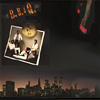
|
1982
(LP & CD)
|
|
|
|
|
1983
(LP & CD)
|
|
|
|

|
1985
(LP & CD)
|
|
All original release years
|
|
 Copyright
© 1999-2025
Copyright
© 1999-2025
|